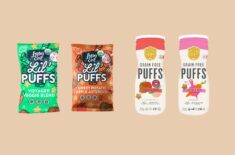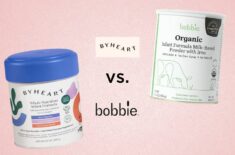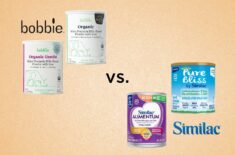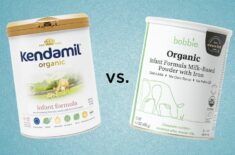Overview
Starting your baby on solids can be an exciting but nerve-wracking time, especially if you’re a first-time parent.
You might be asking questions like:
“How do I recognize if my baby is ready for solids?”
“What baby food should I introduce first?”
“What foods are dangerous for babies?”
As moms ourselves, we know many things to research and learn before giving your baby their first bite of solid food.
So we created a comprehensive guide that answers moms’ common top questions and covers the best baby foods to introduce, how to prepare them, and what to avoid so you can make the most out of this important milestone.
Keep reading to find out more.
Is Your Baby Ready for Solid Foods?
According to the AAP (American Academy of Pediatrics), it is recommended that babies start exploring solid foods at six months. However, many experts and pediatricians suggest introducing solids at four months. (1)
Since each baby is unique, they might show signs of readiness earlier or later than the average. Wherever your baby is on the readiness scale, it’s ok.
Wondering how to know what the major signs to look out for are? Here are some below:
- They can already sit on their own or with support
- Strong head and neck control.
- When you offer food, your baby opens their mouth
- Your baby can swallow the food rather than spit it out of the mouth
- He or she has begun to put objects in their mouth
- Tries to grasp or reach for small objects
- Has developed the coordination to move food from the front of their mouth to the back to swallow
But be sure to consult with a pediatrician before introducing your child to solids, especially if they’re younger than six months old.
What Baby Food Should You Introduce First?
You can start by introducing single-ingredient foods such as fruits and vegetables without added sugar or salt.
Introduce the same new food for 2-3 days before offering other options. This can help you determine which foods might cause an allergic reaction in your baby.
Look out for possible adverse reactions such as rashes, vomiting, or diarrhea.
Once your baby is settled, you can begin combining foods.
Experts still recommend that babies continue breastfeeding or formula-feeding until 12 months of age. (2)
Suggested First Foods
The AAP (American Academy of Pediatrics) states that most children don’t need to stick with a strict food guide. This may be the right opportunity to introduce a variety of foods packed in nutrients.
It may be best to keep your baby’s diet varied while also balanced and nutritious. Not only are you introducing different tastes and textures, but you’re also providing them the crucial nutrients they need to grow, grow, grow!
Wherever possible, try to choose non-GMO and/or organic whole foods or foods that are minimally processed, refined, or contain additives.
Aim to go with varied vegetables, low-sugar fruits like berries, healthy fats such as avocado and ghee. It’s also a good idea to choose grass-fed meats, wild-caught fish and seafood, and pasture-raised poultry if you can.
Offering these options helps ensure that your baby gets optimal nutrition with minimal exposure to possible pesticides, chemicals, and harmful toxins. (1)(3)(16)
Common first foods choices can include:
- Avocado
- Broccoli
- Zucchini
- Cauliflower
- Peas
- Green beans
- Pumpkin
- Sweet potato
- Fruits like bananas, blueberries, kiwi, raspberries, and papaya
- Oats
- Puréed meats
Preparation methods vary depending on whether you choose to purée or practice baby-led weaning. More on this below.
The Top 5 Nutrients Your Baby Needs
As you transition your baby into solids, this can be a good opportunity to provide them with more essential nutrients for their growing bodies’ needs.
Since babies consume small quantities of foods, it’s best to make every bite count.
Here are the top nutrients we recommend for your baby: (4)
- Protein – Helps your child’s body build muscles and repair tissues. Protein-rich foods include beef, eggs, poultry, tofu, yogurt, beans, and lentils.
- Vitamin D – It’s essential in absorbing calcium and phosphorus, which will help your child build strong bones. It can also help prevent rickets, a condition that causes softening of the bones. Foods rich in Vitamin D include fatty fish like salmon and egg yolks. (5)
- Iron – This important mineral can help support brain growth and your child’s learning abilities. Iron-rich foods include red meat (beef, pork, lamb, goat, or venison), seafood, and fatty fish like salmon, poultry (chicken or turkey), and eggs. (6)
- Prebiotics & Probiotics – Probiotics are “good gut bugs” that support your baby’s developing tummy and immune system. Prebiotics are plant fibers that good gut bugs can use for food. Research suggests that probiotics might aid in managing certain conditions and symptoms like diarrhea, allergies, and eczema (characterized by rashes, dry skin, itchy skin, scaly patches, and/or blisters ). (7)
- Omega DHA – Omega-3s (fish oil) are fatty acids that can keep your baby’s brain healthy. DHA (docosahexaenoic acid) is found mainly in certain fish such as salmon, sardines, tuna, and more. DHA can also be found in soybeans, flaxseeds, and chia seeds. (8)
Remember that children’s nutritional needs may differ. It’s best to discuss with your doctor or healthcare provider before starting any supplement or making any major changes to your child’s diet.
Identifying Choking Hazards
Choking is one of the top fears amongst parents of small children. Now that your little one is beginning to learn to chew and swallow solids, the possibility of choking increases. It’s normal to worry about this, and it’s also a good idea to be proactive and learn to identify potential choking pitfalls.
Here are some choking hazards identified by The USDA’s Special Supplemental Nutrition Program for Women, Infants, and Children (WIC): (9)
- Gum and hard candy such as jelly beans or caramels
- Whole nuts and seeds
- Large chunks of cheese
- Hard pretzel, bread, biscuits crackers, or cereals with nuts
- Cooked or raw corn kernel
- Raw hard veggies or fruits like carrots or dried fruit
- Marshmallows
- Uncut grapes, cherry tomatoes, or cherries,
- Uncut sausages or hot dogs
- Cubed ice
- Nut butter or peanut butter
Be Cautious Of These Foods
Allergens
A child might be allergic to almost any kind of food. If you’re worried and unsure, it may be best to proceed with caution when including these foods in your baby’s diet: (2)
- Peanuts
- Sesame
- Tree nuts
- Eggs
- Cow’s milk products
- Gluten & wheat
- Shellfish
- Fish
- Soy
Grains
Many parents choose to proceed with caution when offering grains, particularly wheat. It has gluten protein which is a common allergen.
The following items may also contain wheat protein: (10)
- Grains like spelt, farina, semolina, rye, couscous
- Bread, rolls, muffins, cakes, croutons, and cookies (unless labeled gluten-free)
- Some breakfast or baby cereal, granola, and crackers
- Pasta
- Soy sauce
- Processed meats and deli meats, such as hot dogs, sausages, salami
- Ice cream flavors and ice cream cones
- Thickeners, vegetable gum, and modified corn starch
There are already many gluten-free versions of foods available.
Several studies have shown that the early introduction of allergens might help prevent food allergies.
Before introducing your child to allergenic foods, it’s best to consult a dietitian or pediatrician first. (17)(18)
Meanwhile, The USDA (U.S. Food and Drug Administration) has issued guidance on the presence of inorganic arsenic in infant cereals. (11)
High-Nitrate Foods
Nitrates are an important nutrient from plants. Natural nitrates from vegetables such as spinach contain vitamin C and other minerals. However, added nitrates are a common ingredient in cured or processed meats.
While natural nitrates from vegetables have health benefits, consuming foods high in added nitrites can be harmful.
Babies under four to six months exposed to high levels of nitrate-based additives can be at risk for methemoglobinemia. This is a serious condition known as “blue baby syndrome.” When this condition occurs, the blood cannot circulate oxygen properly, causing babies to turn blue.
Added nitrates can be found in contaminated drinking water and processed or cured meats.
You may want to be cautious when offering: (19)
- Hot dogs
- Ham
- Bacon
- Pork and beef sausage
- Nuggets
- Liver pâté
Try to look for nitrate-free versions of these foods.
Avoid Honey
The AAP recommends that babies shouldn’t be given honey or processed foods with honey before their first year of life. Giving your baby honey before the recommended age can put them at risk for infant botulism.
When a baby eats C botulinum spores in honey, the bacteria may grow in their intestines and lead to toxins in their gut. Infant botulism is characterized by constipation, weak movements, crying, and trouble swallowing. Babies with botulism may also experience breathing difficulties. (20)
To help prevent botulism in your baby, keep them away from raw honey and other products with honey. Even a small taste can put your baby at risk. You can also avoid exposure to contaminated soil or dust. These can also contain C. botulinum spores that babies can inhale into their lungs. (20)
How Do I Prepare My Baby’s Food?
The answer will depend on whether you’re choosing to start solely with purées or if you’re going the baby-led weaning (BLW) route.
You can mash, strain, and purée foods to gradually transition your baby to solids.
If you choose to practice the BLW methodology, then you’ll want to allow your baby the opportunity to self-feed rather than be spoon-fed by you. In this approach, you prepare various finger foods and allow your baby to direct their sensory experience.
Here are more tips to bear in mind when preparing baby’s food:
- For cylindrical foods like sausage or string cheese, cut it into strips.
- For round-shaped foods such as grapes and cherry tomatoes, you can keep the small pieces at no bigger than ½ inch or mash them up.
- For hard foods like carrots, steam them until soft enough to mash with a fork.
- It can be a good idea to remove the pits and tough skins of fruits and vegetables.
- Before serving, you can remove the skin and fat from meat, poultry, and fish.
- Serve bones such as rib bones bare without skin or tissues.
Helpful Tools & Equipment
- High chair
- Cloth or silicone bibs
- BPA-free soft weaning spoons, bowl, and baby cups
- A messy mat or tray
- Containers such as small glass jars for batch cooking and freezing.
Baby-Led Weaning vs Purée: Which Method Is Better?
While making purées is the most common method, more parents are now exploring the benefits of baby-led weaning.
This method suggests that babies skip spoon-fed, puréed food instead of feeding themselves with age-appropriate and safely prepared finger foods.
While both methods have benefits and drawbacks, we’ve written an entire piece on how they compare with each other.
Feeding Your Baby Their First Solid Foods
Now, are you ready to get messy? Be prepared for the inevitable sticky hands, messy plate, and the inevitable nervous moment or tears. Whatever happens, your baby’s first feeding is likely to be a milestone worth remembering.
Here are some things you may bear in mind:
How Much Food Do I Give My Baby For The First Time?
Start with small portions. At this stage, feeding is only for fun and sensory development! Don’t sweat it too much. Remember that your baby’s main source of nutrition is still your breast milk or infant formula. There’s no right or wrong amount for their first feeding.
How Many Times In A Day Should My Baby Eat Solid Foods?
Get your child comfortable with solid foods first by starting slow with 1 meal a day. If and when you notice your baby is ready for more, gradually increase the frequency as needed. For example, experiment with feeding solids twice or even three times a day.
What if My Baby Rejects The Food?
Don’t force it. It’s totally normal for babies to reject foods they’re trying for the first time. Again, this is a huge milestone, and your baby needs to get used to new tastes and textures. Give them another try after five days. If your baby continues to resist solids, contact your pediatrician. (2)
Should I Give My Baby Water?
Please consult with your pediatrician before offering your baby water. Most doctors will green-light you to give your baby water between 6 to 12 months of age. The recommended amount of water you may give your baby will vary depending on what your pediatrician says. (13)
How Do I Tell If My Baby Is Already Full?
Let your child decide how much food they want. Here are signs that your baby is already full: (14)
- He or she turns their heads away from food
- Pushes food away
- When you offer another bite, your baby closes their mouth
- He or she uses hand motions or signals to show they don’t want food anymore
What Changes Can You Expect After Your Baby Starts Solids?
As your baby transitions to solid foods, they may also drink less milk. You might also notice changes in your baby’s stool. They might become more constipated or gassy.
As babies eat more solids, their stools can become stronger in odor. It might also become more firm and variable in color.
If you don’t strain their food, you’ll even notice pieces of food such as peas or corn in their stool. It’s normal to be concerned if you notice changes.
Just keep in mind that this is a normal part of your baby’s transition.
If your baby develops extremely loose, watery stools, or you notice mucus, it may mean that your baby’s gut is irritated.
Always check with your pediatrician if you notice any significant or persistent digestive changes. (15)
Helping Your Baby Develop Healthy Eating Habits
It’s a good idea to develop your baby’s good eating habits early on. Remember that your baby learns via observation, so try to model healthy eating for them. Good eating habits can include:
- Learning to be fully present with food, without distractions like television or screens
- Sitting upright while eating
- Eating slowly and not in a hurry
Your child will likely not finish their portions, especially at first. Eventually, you can teach them to determine when they’re satiated to learn that it’s fine to stop when full.
Letting your baby join during family mealtimes can also be a great way to bond and learn. Research suggests that spending mealtimes together as a family can positively affect the baby’s development. (15)
Do’s and Don’ts From the Experts
The following are some common best-practices tips to keep in mind: (3)
- It’s a misconception that putting cereal in a baby’s bottle may help them sleep through the night. Solids inside a baby’s bottle can be a choking hazard.
- Always supervise your child while eating.
- Instead of feeding your baby from a jar, you can get a portion of baby food from a jar and place it in a bowl. Feeding on a jar might expose your baby to harmful bacteria.
- Avoid giving honey and products with honey until they are over one year old. Feeding honey can put your baby at risk for dangerous foodborne diseases like infant botulism.
- Discuss any allergy concerns with your doctor immediately. (If you or anyone in your baby’s immediate family has a peanut allergy, it’s best to consult your doctor right away.)
REFERENCES
:
- https://www.cdc.gov/nutrition/infantandtoddlernutrition/foods-and-drinks/when-to-introduce-solid-foods.html
- https://www.mayoclinic.org/healthy-lifestyle/infant-and-toddler-health/in-depth/healthy-baby/art-20046200#:~:text=The%20American%20 Academy%20of%20 Pediatrics,%2Dfeeding%20or%20formula%2Dfeeding
- https://www.eatright.org/food/nutrition/eating-as-a-family/dos-and-donts-for-babys-first-foods
- https://www.ncbi.nlm.nih.gov/books/NBK560758/
- https://www.mayoclinic.org/healthy-lifestyle/infant-and-toddler-health/expert-answers/vitamin-d-for-babies/faq-20058161
- https://www.cdc.gov/nutrition/InfantandToddlerNutrition/vitamins-minerals/iron.html
- https://publications.aap.org/pediatrics/article/126/6/1217/65014/Probiotics-and-Prebiotics-in-Pediatrics
- https://www.eatright.org/food/vitamins-and-supplements/types-of-vitamins-and-nutrients/do-kids-need-omega-3-fats
- https://wicworks.fns.usda.gov/sites/default/files/media/document/English_ReducingRiskofChokinginYoungChildren.pdf
- https://www.mayoclinic.org/diseases-conditions/wheat-allergy/symptoms-causes/syc-20378897
- https://www.fda.gov/news-events/fda-newsroom/fda-brief-fda-takes-action-limit-inorganic-arsenic-levels-infant-rice-cereal
- https://motherhoodcommunity.com/baby-led-weaning-vs-purees/
- https://www.cdc.gov/nutrition/InfantandToddlerNutrition/foods-and-drinks/foods-and-drinks-to-encourage.html
- https://www.cdc.gov/nutrition/infantandtoddlernutrition/mealtime/signs-your-child-is-hungry-or-full.html
- https://www.healthychildren.org/English/ages-stages/baby/feeding-nutrition/Pages/Starting-Solid-Foods.aspx
- https://www.nhs.uk/start4life/weaning/what-to-feed-your-baby/around-6-months/#anchor-tabs
- https://www.nejm.org/doi/full/10.1056/NEJMoa1414850 LEAP study allergy
- https://www.ncbi.nlm.nih.gov/pmc/articles/PMC4046529/ allergy study
- https://www.ncbi.nlm.nih.gov/pmc/articles/PMC7464959/ nitrates
- https://www.healthychildren.org/English/health-issues/conditions/infections/Pages/Botulism.aspx#:~:text=The%20American%20Academy%20of%20Pediatrics,minutes%2C%20which%20can%20destroy%20toxins.












